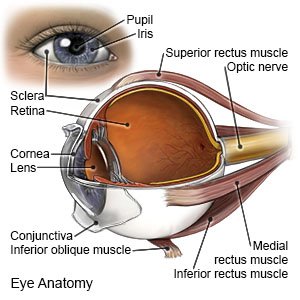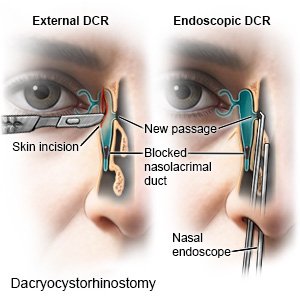Dcr (Dacryocystorhinostomy)
Medically reviewed by Drugs.com. Last updated on Aug 4, 2025.
What do I need to know about DCR?
DCR is surgery to open a blocked tear duct. During surgery, a new path is created from the inner corner of your eye into your nose. This helps tears drain directly into your nose.
 |
How do I prepare for DCR?
- Your surgeon will talk to you about how to prepare for surgery. You may be told not to eat or drink anything after midnight on the day of your surgery. Arrange to have someone drive you home when you are discharged.
- Tell your surgeon about all your current medicines. Your surgeon will tell you if you need to stop any medicine for surgery, and when to stop. Your surgeon will tell you which medicines to take or not take on the day of your surgery.
- Tell your surgeon about any allergies you have, including to anesthesia or medicines. You may be given an antibiotic to help prevent a bacterial infection.
- Your surgeon will tell you if you need any tests before your surgery, and when to have them.
What will happen during DCR?
- You may be given general anesthesia to keep you asleep and free from pain during surgery. You may instead be given local anesthesia to numb the area. You will be awake with local anesthesia, but you should not feel pain. Material soaked in anesthesia may be packed into your nose. The packing may also have medicine to help control bleeding.
- For external surgery, your surgeon will make a small incision along your lower eyelid, next to your nose. Your surgeon will make a small hole in the bone to open a new drainage connection. For endoscopic surgery, an endoscope is inserted into your nose and up to the eye area. If your surgeon has trouble getting to or seeing the area, a septoplasty may be needed. This is surgery to cut and reattach your septum (tissue that separates your nostrils).
- A small piece of bone will be removed so your surgeon can create a connection between your eye and nasal cavity. A stent may be placed to keep the created duct open. If you had an incision, it may be closed with stitches or medical glue.
 |
What will happen after DCR?
Gauze may be placed below your nose to catch any blood or fluid that comes out. You may have an ice pack on your nose. The inside of your nose may be packed with gauze to decrease bleeding. You may have bruising or swelling around your nose or eye.
What are the risks of DCR?
You may bleed more than expected or develop an infection. You may have a permanent surgery scar if your surgeon made an incision. Tissue in your nose may fuse together. A tube used to keep the new duct open may fall out or move out of place. Surgery may not work, and you may continue to have watery eyes.
Care Agreement
You have the right to help plan your care. Learn about your health condition and how it may be treated. Discuss treatment options with your healthcare providers to decide what care you want to receive. You always have the right to refuse treatment. The above information is an educational aid only. It is not intended as medical advice for individual conditions or treatments. Talk to your doctor, nurse or pharmacist before following any medical regimen to see if it is safe and effective for you.© Copyright Merative 2025 Information is for End User's use only and may not be sold, redistributed or otherwise used for commercial purposes.
Further information
Always consult your healthcare provider to ensure the information displayed on this page applies to your personal circumstances.
